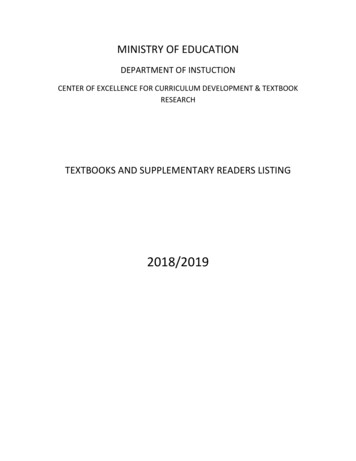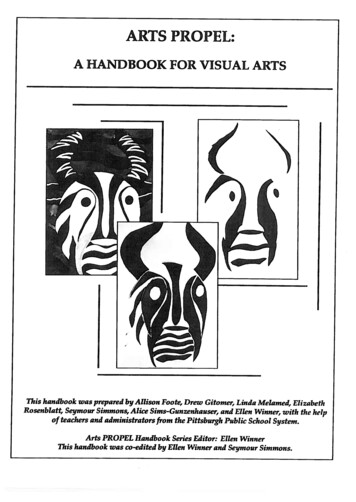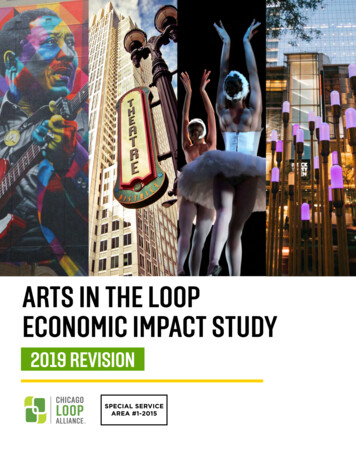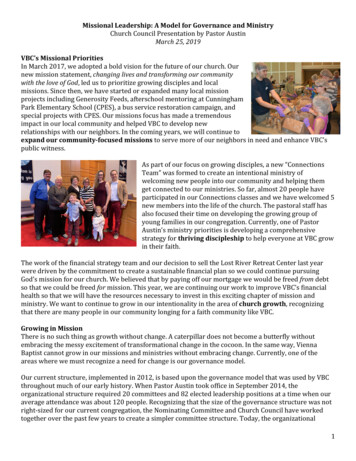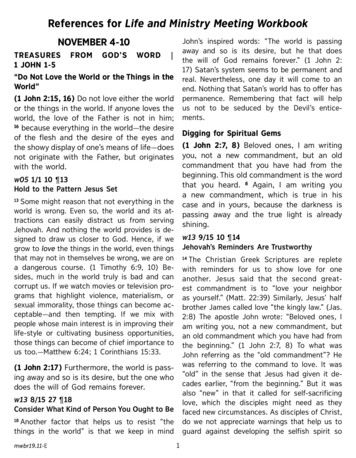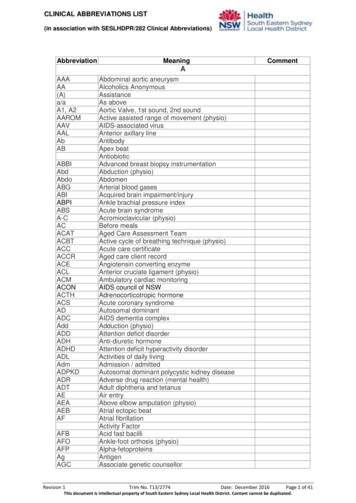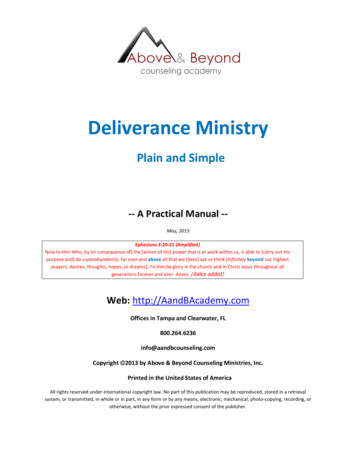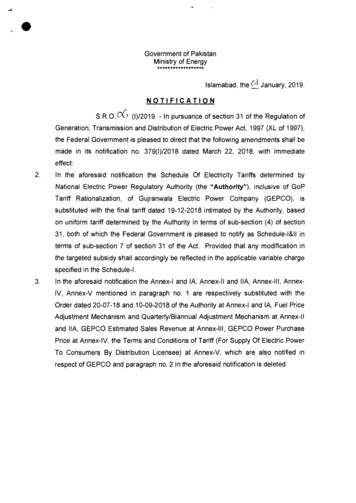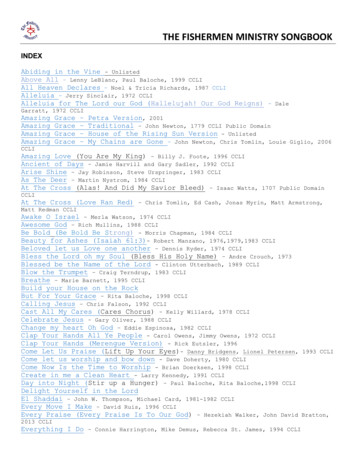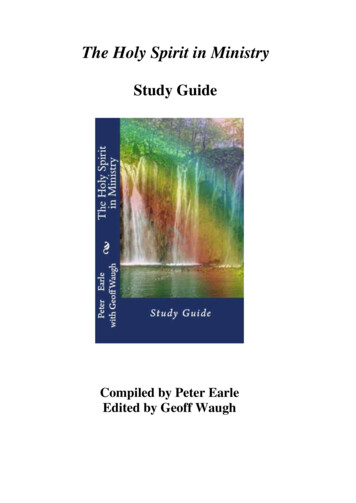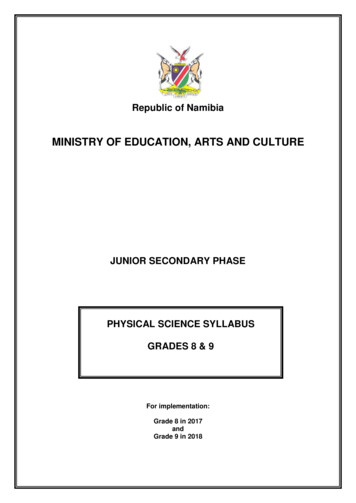
Transcription
Republic of NamibiaMINISTRY OF EDUCATION, ARTS AND CULTUREJUNIOR SECONDARY PHASEPHYSICAL SCIENCE SYLLABUSGRADES 8 & 9For implementation:Grade 8 in 2017andGrade 9 in 2018
Ministry of EducationNational Institute for Educational Development (NIED)Private Bag 2034OkahandjaNamibia Copyright NIED, Ministry of Education, 2015Physical Science Syllabus Grades 8 & 9ISBN: 978–99945–2–113-5Printed by NIEDWebsite: http://www.nied.edu.naPublication date: December 2015
TABLE OF CONTENTS1.Introduction . 12.Rationale . 13.Aims. 14.Inclusive education . 25.Links to other subjects and cross-curricular issues . 36.Approach to teaching and learning . 47.End-of-phase competencies . 58.Summary of the learning content . 79.Learning content . 89.1Introduction to learning content . 89.2Learning content . 910.Assessment . 5210.1Continuous assessment . 5210.2Formative and summative assessment . 5210.3Informal and formal methods . 5310.4Evaluation . 5310.5Criterion-referenced grades . 5310.6Grade descriptors . 5410.7Conducting and recording assessment . 5410.8Assessment objectives. 5410.9Continuous assessment: detailed guidelines. 5610.10End-of-year examinations: detailed guidelines . 5710.11Promotion marks . 5810.12Specification grid. 5910.13Assessment Criteria . 59Annexe 1Glossary of terms used in science teaching and assessment activities . 61Annexe 2Numbers and formulas . 63Annexe 3Symbols, units and definitions of physical quantities . 64Annexe 4:Assessment record sheet for Grade 8, terms 1 and 2 . 65Annexe 5:Assessment record sheet for Grade 8, term 3 . 66Annexe 6:Assessment record sheet for Grades 9 . 67
1.IntroductionThis syllabus describes the intended learning and assessment for Physical Science in theJunior Secondary phase. As a subject, Physical Science is within the natural sciences areaof learning in the curriculum, but has thematic links to other subjects across the curriculum.The subject Physical Science places strong emphasis on the learners’ understanding of thephysical and biological world around them at the local, regional and international levels. Itthus includes how societies use natural resources to satisfy their needs, and how theenvironment may be changed in ecologically sustainable ways. At this phase and subjectarea, the application of scientific knowledge and attitudes to health is of special relevance forthe individual, the family, and society as a whole.2.RationaleThe particular features of Physical Science at this phase are as follows:Learning experiences in the natural science area are focused upon promoting the teachingand learning for understanding. Namibia, like most African countries, is rich in naturalresources. The exploration of these resources requires scientific knowledge and relevantskills. The acquisition of scientific knowledge and skills presents itself as a prerequisite for aprogressive national economy and the improved standard of life for our people. It is thusimportant for our learners to acquire knowledge and skills which will foster theirunderstanding of the interaction of human beings and the environment in order to satisfyhuman needs. It must be understood that the physical and biological world around us is quitecomplex and therefore needs to be understood in a holistic manner by the society in order tosustain natural resources.The sustainability of our natural resources, however, requires advanced technology throughthe efficient and effective usage of equipment, materials and processes. Modern technologyis required in order to assist our learners and society to solve problems through planning,design, realisation, and evaluation of activities and goals.3.AimsThe main aim of the syllabi in the natural sciences area is therefore to provide basic scientificbackground for our learners with the hope of producing the much-needed scientists for thecountry. The Namibian society needs to be scientifically literate if they are to cope with thechallenges of appropriate global technology requirements.The subject Physical Science, within the natural science area, promotes the following aims inthe curriculum guide:3.1 Knowledge with understandingdevelop knowledge, understanding, creativity, practical and experimental skills as asolid foundation for academic training to prepare learners for creative and meaningfuladult lifehelp learners develop self-confidence, self-knowledge and understanding of the worldin which they live, through meaningful scientific activitiesPhysical Science syllabus Grades 8 - 9, NIED 20151
3.2 3.3 3.4 4.Values and attitudesdevelop a sense of responsibility towards the environment, relating scientific practicesto sustainable use of natural resourcesdemonstrate desirable behavioural patterns and frame of mind in interacting with theenvironment in a manner that is protective, preserving and nurturingdevelop attitudes and practices, further knowledge and activities that promote thephysical and mental health of the societydevelop and enhance respect for, understanding of, and tolerance of other people’sbeliefs, cultures and way of lifeScientific skillsdevelop a lively, questioning, appreciative and creative intellect to enable learners todiscuss issues rationally, make careful observations and analysis, think scientifically,solve problems and apply them to taskspromote Information Communication Technology (ICT) as a tool to enhanceunderstanding of the learning contentDemocratic principlespromote equality of opportunity for males and females, enabling both sexes toparticipate equally and fully in all spheres of society and fields of employmentlay a foundation for informed and responsible attitudes and choices towards thebalance of population growth, ecological sustainability, and the quality of life for allcitizens of NamibiaInclusive educationInclusive education is the right of every learner and promotes access to and participation inthe full range of educational programmes and services offered by the education system inmainstream schools. It is based on the principle of supporting and celebrating the diversityfound among all learners and removing all barriers to learning. The Physical Scienceteacher in the Junior Secondary phase should therefore accommodate learners with specialeducational needs by adapting this syllabus to the needs of the learner through differentiationof teaching methods and material as indicated in the Curriculum Framework for InclusiveEducation: A Supplement to the National Curriculum for Basic Education (2014). Theadaptation for assessment of learners with special educational needs must be done asprescribed in the Handbook for Centres (2014) by the Directorate of National Examinationsand Assessment (DNEA). The accommodations prescribed in this handbook are not only forexternal examinations, but apply to learners from Grade 1 to 12.Learners who are so severely impaired that they cannot benefit from attending mainstreamschools will be provided for according to their needs in learning support units, resource unitsor resource schools until such time that they can join a mainstream school structure, ifpossible.The subjects in the natural sciences and Mathematics area are basic to foster logical thinkingskills and form part of the foundation needed for pursuing most careers. Therefore includinggender perspectives is important for the science curriculum in order to raise awareness ofPhysical Science syllabus Grades 8 - 9, NIED 20152
gender stereotyping (e.g. gender roles we previously associated with doctors, nurses,farmers, artisans, mechanics, lawyers etc.). Teachers are obliged to promote gender equityin all spheres of life. In all activities carried out within the scientific area of study, femalelearners should experience the confidence, which will motivate them to continue in thenatural science stream throughout their school career and beyond.5.Links to other subjects and cross-curricular issuesThe cross-curricular issues include environmental education, HIV and AIDS, populationeducation, education for human rights and democracy, information and communicationtechnology (ICT) and road safety. These issues have been introduced to the formalcurriculum, because each of the issues deals with particular risks and challenges in ourNamibian society. They should be dealt with across all phases and in every subject wherethe topics overlap with the content of that subject.All of our learners need to: understand the nature of these risks and challenges;know how they will impact our society and the quality of life of our people now and in thefuture;understand how these risks and challenges can be addressed on a national and globallevel; andunderstand how they can play a part in addressing these risks and challenges in theirown school and local community.The main risks and challenges have been identified as the challenges and risks: we face if we do not care for and manage our natural resources; caused by HIV and AIDS; to health caused by pollution, poor sanitation and waste; to democracy and social stability caused by inequity and governance that ignores rightsand responsibilities; we face if we do not adhere to road safety measures; we face because of globalisation.Physical Science syllabus Grades 8 - 9, NIED 20153
Since some subjects are more suitable to address specific cross-curricular issues, thoseissues will receive more emphasis in the particular syllabuses.In this syllabus the following cross-curricular issues can be dealt with in the topics asindicated:Cross-curricular issuesEnvironmental LearningGrade 8Matter and materialsTopic 2 MatterEnvironmental chemistryTopic 3 The Gases of theairMechanicsTopic 4 ForcesGrade 9Matter and materialsTopic 2 MatterEnvironmental chemistryTopic 3 Acids, alkalis (bases), metalsand non-metalsMechanicsTopic 4 MechanicsICTScientific processes andexperimental techniquesTopic 1 Scientific processesEnvironmental chemistryTopic 3 The Gases of theairScientific processes andexperimental techniquesTopic 1 Scientific processesEnvironmental chemistryTopic 3 Acids, alkalis (bases), metalsand non-metalsEHRD6.Approach to teaching and learningThe approach to teaching and learning is based on a paradigm of learner-centred education(LCE) described in ministerial policy documents and the learner-centred educationconceptual framework. This approach ensures optimal quality of learning when theprinciples are put into practice.The aim of learner-centred education is to develop learning with understanding, and to impartthe knowledge, skills and attitudes that contribute to the development of society. The startingpoint for teaching and learning is the fact that the learner brings to the school a wealth ofknowledge and experience gained continually from the family, the community, and throughinteraction with the environment. Learning in school must involve, build on, extend andchallenge the learner’s prior knowledge and experience.Learners learn best when they are actively involved in the learning process through a highdegree of participation, contribution and production. At the same time, each learner is anindividual with his/her own needs, pace of learning, experiences and abilities. The teachermust be able to identify the needs of the learners and the learning that still needs to takeplace, and know how to shape learning experiences accordingly. Teaching strategies musttherefore be varied and flexible within well-structured sequences of lessons.The teacher must decide, in relation to the general and specific objectives to be achieved,when it is best to convey content directly; when it is best to let learners discover or exploreinformation for themselves; when they need directed learning; when they need reinforcementor enrichment learning; when there is a particular progression of skills or information thatneeds to be followed; or when the learners can be allowed to find their own way through atopic or area of content.Work in groups, in pairs, individually, or as a whole class must therefore be organised asappropriate to the task in hand. Co-operative and collaborative learning should beencouraged wherever possible. In such cases, tasks must be designed so that pair or groupwork is needed to complete it, otherwise the learners will not see any relevance in carryingout tasks together. As the learners develop personal, social and communication skills, theyPhysical Science syllabus Grades 8 - 9, NIED 20154
can gradually be given increasing responsibility to participate in planning and evaluating theirwork, under the teacher’s guidance.7.End-of-phase competenciesA few learners might not be able to achieve all the specific objectives satisfactorily and mustreceive learning support through adapted teaching approaches, adapted materials, andassistance from peers. A small number of learners have special educational needs to adegree which requires greater individual attention, resources or assessment. Others willhave impairments which do not necessarily limit cognitive and affective learning anddevelopment, e.g. the visually impaired, hearing impaired and physically challenged.On completing of the Junior Secondary phase, learners are expected to be able to:Scientific processes use methods and skills to follow a sequence of instructions; use appropriate techniques;handle apparatus/material competently and have due regard to safety; make, recordand convert units of estimates and measurements of length, volume, time, temperature,mass, electrical quantities, area, volume, amount of substance and use SI units; start observations and classification determining dependent, independent and controlvariables in existing scientific models in order for models to reflect real-life situations.Understand the importance of recording and communicating results from experimentalinvestigations; use methods, skills of simple scientific models and where possible ICT on the basis ofexisting and new information to communicate to other people, both scientists and nonscientists, their investigations, analyses and conclusions using basic scientific andmathematical language.Matter & materials investigate and differentiate chemical combustion, decomposition, synthesis andneutralization reactions and be able to formulate word equations for these reactions; know the three states of matter to communicate nature and characteristics of physicalchange and chemical change, observations and conclusions using the kinetic particletheory of matter and the atomic model leading to the understanding of the physicalproperties and reactions of gases as well as their advantages, uses and disadvantagesin everyday life; understand that the world around us is made up from the elements on the PeriodicTable and that the Periodic Table is a specific arrangement of the elements, in periodsand groups, according to their atomic numbers and atomic structures; understand that atoms combine to form the building blocks of all material, ionic andcovalent bonding, properties and reactions within the Periodic Table. Understandcovalent bonding and know how to illustrate covalent bonding as the sharing ofelectrons when atoms bind (restricted to H2O, H2, O2, CO2, CH4 , diatomic molecules ofgroup 7 & N2). Know how to illustrate ionic bonding as the transfer of electrons to formoppositely charged ions which attract electrostatically.Physical Science syllabus Grades 8 - 9, NIED 20155
Environmental chemistry know the composition, occurrence, reaction, uses and production of gasses in air andrealise that the properties of the gases in air have certain consequences in nature and inindustry; know acids and bases in everyday life, their properties and reactions that they canundergo. Relate acids’ chemical composition to hydrogen ions and negative anions andthe pH scale from 0 to less than 7 to measure acid strength and from more than 7 to 14to measure the strength of an alkali; know the nature, the effect on indicators and the reactions of acids and alkalis (bases).Understand neutralisation as a reaction between bases and acids. Know the pH scaleand be able to relate the pH of strong and weak acids and alkalis and the pH of purewater; know metal and non-metal properties and how to arrange them in order of reactivity.Understand the reactions and write word equations between metals (Group I and II)oxides and acids; metal (Group I and II) hydroxides and acids and carbonates andacids. Outline the important metals mined in Namibia and be able to write wordequations of metal and non-metal reactions.Mechanics communicate their physical observations and conclusions using scientific andmathematical language and theories to explain the source, nature, transmission,properties and effects of forces, energy and magnetism, light and waves, static andmoving charge electrical energy in the day to day living and have a due regard for safetyand conservation of resources. Formulate scientific formulae and do completecalculations of force, friction, work, power, pressure, weight, mass and density and knowthe apparatus used to measure these quantities (In Grade 8 and 9 only calculations arerequired where the force and the distance are in the same direction e.g. ether bothvertically or both horizontally); know various forms, sources and characteristics of energy, the law of conservation ofenergy and energy transfer and recognise that energy takes various forms that can beclassify based on their interaction with matter. Understand the properties of light, inparticular that light travels in a straight line and demonstrate an understanding that thesun is the principal source of energy; know how to measure and understand from the kinetic particle theory of matter thebehaviour of gases and liquids for phenomena such as gas pressure (includingatmospheric pressure) and pressure in liquids (under the surface of the liquid); understand the forces of flotation (without defining Archimedes principle)and use densityto determine whether an object will float or sink in a liquid.Electricity and magnetism know the existence of charge, current, resistance and voltage. Know how to constructsimple circuits and draw the circuit symbols and use multi meters or analogues metersto measure current, resistance and potential difference at any place in a circuit; know effects on current and potential difference when bulbs, resistors and cells areconnected in series and parallel; understand magnetism and magnetic properties and uses of magnets.Physical Science syllabus Grades 8 - 9, NIED 20156
8.Summary of the learning contentTeachers should realise that there are certain aspects of the syllabus that should not betaught as separate entities and at fixed times during the school year. These includeincidental topics such as general knowledge, field trips, project work, investigations andobservations including social events.Table: Summary of learning content for Grade 8 - 9 Physical ScienceGrade 8Grade 9Scientific Processes and Experimental TechniquesTopic 1Scientific processesTopic 1Scientific processesMatter and MaterialsTopic 2MatterTopic 2MatterEnvironmental ChemistryTopic 3The Gases of the airTopic 3Acids, alkalis (bases), metals and nonmetalsMechanicsTopic 4ForcesTopic 4MechanicsElectricity and MagnetismTopic 5ElectricityTopic 5Physical Science syllabus Grades 8 - 9, NIED 20157Electricity and magnetism
9.Learning content9.1Introduction to learning content1.The learning content outlined below is designed to provide guidance to teachers as to what will be assessed in the overall evaluation oflearners. It is not meant to limit, in any way, the teaching programme of any particular school.2.Topics and Sub-topics refer to those components of the subject which learners are required to master.The General objectives are derived from the topic/skill and are the general knowledge, understanding and demonstration of skills on whichlearners will be assessed.The Specific objectives are the detailed and specified content of the syllabus, which learners need to master to achieve the generalobjectives, and on which they will be assessed.3.Suggestions for practical activities or demonstrations are included at the end of each topic. These suggestions for practical activities ordemonstrations are considered essential and all learners should be exposed to them, both during teaching and as preparation forassessment.Physical Science syllabus Grades 8 - 9, NIED 20158
9.2Learning content9.2.1Grade 8 learning contentTOPIC 1SCIENTIFIC PROCESSESThis topic is an introduction to some of the basic scientific skills. The skills in this topic should not be taught in isolation, as they form an integral partof the other topicsGENERAL OBJECTIVESGRADE 8 SPECIFIC OBJECTIVESLearners will:Learners should be able to:1.1Estimating and measuring know how to estimate and measure find a measurement by following a sequence of instructions; use appropriate techniques; handlevolume, length, mass, time andapparatus/material competently and have due regard to safetytemperature estimate or measure and record area, volume, length, mass, time and temperature convert units of length, mass, time, area and volume1.2Stating the aim (question) of an investigation realise the value of investigations to outline that investigations are a way to find out new information, explore the world around us,understand the world around us anddevelop new ideas to explain the world around us and to check the results of other scientiststo check the results of other explain the first steps to an investigation as:scientists- choosing the right question or aim of the investigation- planning how to collect information or data explain how to make a test fair by identifying an appropriate control explain the importance of a zero reading or the use of a control identify dependent (what you measure) and independent variable (what you are changing) explain direct proportionality and inverse proportionPhysical Science syllabus Grades 8 - 9, NIED 20159
GENERAL OBJECTIVESLearners will:1.3Observing and classifying know how to observe properties of avariety of substances and group(classify) objects in a variety of waysGRADE 8 SPECIFIC OBJECTIVESLearners should be able to: 1.4Recording and presenting results understand the importance ofrecording and communicatingresults from experimentalinvestigations to other people, bothscientists and non-scientists (theuse of ICT can be incorporated inthis objective) describe and record observations accurately of all practical activities in Grade 8 (NOTE: observe inscience should be the use of five senses: sight, smell, hearing, touch and taste – we do not usuallyuse sense of taste as that could be dangerous; very often the conclusion and observation areconfused, e.g. water boils is a conclusion while bubbles formed is the observation)analyse and compare properties of substancesrecord results of experimental investigations in a logical manner, e.g. in tables and graphs (the useof ICT is suggested)draw up/tabulate results of an investigation in tables, heading each column of the table with thename of the physical quantity and the appropriate unit (e.g. time /s)select suitable scales and axes for graphsplot the independent variable on the x-axis (horizontal axis) and plot the dependent variable on they-axis (vertical axis)label each graph with the appropriate heading (by convention always the dependent versusindependent variable)label each axis with the physical quantity and the appropriate unit, e.g. time/ssketch graphs with the appropriate title (by convention and for consistency with Mathematics andBiology the heading will always have the dependent vs. the independent as title)Physical Science syllabus Grades 8 - 9, NIED 201510
The practical activities, approaches or demonstrations required for Grade 8, Topic 1 Scientific Processes are listed below. These areconsidered basic and all learners should be exposed to them as a minimum requirement.1.1Estimating & measuring estimate and measure length, mass, time and temperature estimate and measure or calculate volume and area build models of 1 dm3 and 1 cm3 containers determine the volume of a liquid, an irregularly shaped object and the classroom measure the temperature changes of heating water1.2Stating the aim (question) of an investigation no minimum activity suggested; if time permits teachers can do alternative activities relevant to topic1.3Observing and classifying group common objects in a number of different ways (cross reference to 2.2.1) observe the effects on the current and the potential difference in different parts of a circuit when:- cells are connected in series and parallel- bulbs are connected in series and parallel (cross reference to 5.7)1.4Recording and presenting results record the length, mass, time and temperature of the heating of water (cross reference to 1.1) present the results of heating of water (cross reference to 1.1)Physical Science syllabus Grades 8 - 9, NIED 201511
TOPIC 2MATTERGENERAL OBJECTIVESGRADE 8 SPECIFIC OBJECTIVESLearners will:Learners should be able to:2.1Nature of matter: physical and chemical changes know the nature and characteristicsof physical change and chemicalchange, the three states of matterand the kinetic particle theory ofmatter describe physical change and chemical changedistinguish between a physical and a chemical changeoutline a chemical change by representation in general terms in the formreactants productsgive examples of chemical changes or reactions in everyday life and industrial processeswrite down chemical changes in the form of word equationsdescribe changes in everyday life and in industry and identify them as physical or chemical changes(cross reference to 1.3)identify a variety of substances by their colour, smell, taste, melting point and boiling point andinvestigate properties of different substancesoutline the three states of matteroutline the kinetic particle theory of matter as:- matter consists of particles- there are spaces between the particles- the particles move continuously- the particle movement or speed depend on the temperature- there are attracting forces between the particles which keep an object togetherinterpret by means of the kinetic particle theory of matter the processes of expansion, compressibilityand diffusion in solids, liquids and gases and changing state (cross reference to 1.3)outline the processes of sublimation (e.g. ammonium chloride, carbon dioxide, sulfur, iodine,naphthalene) (cross reference to 1.3)Physical Science syllabus Grades 8 - 9, NIED 201512
GENERAL OBJECTIVESLearners will:2.2Building blocks of matter2.2.1 Elements, compounds and mixtures understands elements, mixtures andcompoundsGRADE 8 SPECIFIC OBJECTIVESLearners should be able to: 2.2.2 Periodic Table understand that the world around usis made up of the elements on thePeriodic Table understand that the Periodic Tableis a specific arrangement of theelements, in periods and groups,according to their atomic numbersand atomic structuresdistinguish between elements, mixtures and compoundsoutline that mixtures can be separated by a physical process while compounds only by a chemicalprocess (cross reference to 2.1)outline that mixtures show the properties of their components while compounds do notname practical examples of the most common elements, compounds and mixtures found ineveryday life, the Earth’s crust, the atmosphere and waterexplain that elements and compounds are used in everyday life (e.g. in medicines, materials,fertilisers and household chemicals) identify the first 20 elements (names and symbols) of the Periodic Table and also those of iron,copper, zinc, silver, tin, iodine, gold, mercury, lead and uranium relate t
Physical Science syllabus Grades 8 - 9, NIED 2015 1 1. Introduction This syllabus describes the intended learning and assessment for Physical Science in the Junior Secondary phase. As a subject, Physical Science is within the natural sciences area of learning in the curriculum, but ha
